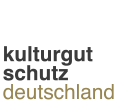Monument conservation acts
A number of the monument conservation acts adopted by the Länder also contain provisions on the protection of movable cultural property.
Generally speaking, the scope of application of the monument conservation acts encompasses objects which are particularly significant and whose preservation is therefore in the public interest. This always applies in the case of objects that are significant in artistic, scientific or historical/local historical terms; in certain Länder, however, preservation may also be in the public interest because the objects are significant for folkloric, urban planning, technological, religious or other reasons.
Relevance in terms of movable cultural property
The monument conservation acts may offer protection for movable objects as separate movable monuments or as accessories, fittings or fixtures of a monument (in most cases an architectural monument).
In certain Länder, however, restrictions apply to separate movable objects (such as movable monuments or archival records):
- The acts adopted by Brandenburg and Saarland apply to archival records only if these latter are not subject to any specific statutory provisions.
- The acts adopted by Mecklenburg-Western Pomerania, North Rhine-Westphalia and Schleswig-Holstein do not grant any protection to archival records.
- The act adopted by Berlin applies only to archaeological monuments.
- According to the act adopted by Bremen, movable cultural monuments must be of particular significance for Bremen’s history.
- According to the act adopted by Lower Saxony, movable monuments must have been created by or shaped by humans, or provide information about human life in previous eras.
- According to the act adopted by Schleswig-Holstein, movable cultural monuments must hold a special significance for the history and culture of Schleswig-Holstein, constitute national cultural property or require protection on the basis of international recommendations.
Movable objects that qualify as accessories, fittings or fixtures of a monument and are therefore deemed equivalent to a monument are always covered by the scope of these acts. Movable archaeological monuments (archaeological finds) are always subject to specific duties of reporting and surrender, and approval must be obtained prior to archaeological searches.
Eligibility of movable monuments
Monuments are typically entered in a register of monuments, but this is not a prerequisite for protection. In most Länder, monuments can be protected even if they have not been entered in such a register as long as they meet the statutory requirements for qualification as a monument.
This applies to separate movable monuments only in Berlin, Baden-Württemberg, Brandenburg, Saxony and Saxony-Anhalt. In all other Länder, these monuments are eligible for protection only if they have been entered in a register of monuments. In certain Länder, particular requirements that go beyond simply qualifying as a monument must also be met before protection is granted:
- In Baden-Württemberg, movable cultural monuments are entered in a register as a cultural monument of particular significance only if: (1) the owner applies for the entry; (2) the monuments are of more than mere local significance or have special ties to the cultural sector of the Land; (3) they constitute cultural property of national significance; (4) they constitute archives of national significance or archives that are significant in terms of Land or local history; or (5) they require protection on the basis of international recommendations.
- In Bavaria, movable monuments are entered in a register of monuments only upon request by the party concerned or in particularly important cases.
- In Hessen and Thuringia, a movable monument must be an object which has historically justified links to a particular location, and whose continued presence in that location is in the public interest (the relevant provisions of Thuringia’s act are restricted to objects created by graphic and plastic artists).
- In Hamburg, Mecklenburg-Western Pomerania, Lower Saxony and North Rhine-Westphalia, movable monuments are entered in a register only if they are of special or outstanding significance.
- In Rhineland-Palatinate, movable monuments are entered in a register only upon the suggestion of the owner or if special significance can be ascribed to them.
- In Saarland, the object must have special links with the Land’s cultural sector, constitute cultural property of national significance or an archive of national significance or an archive of significance in terms of Land or local history or a substantial part thereof, or require protection on the basis of international recommendations.
- In Saxony, movable cultural monuments are also entered in a register on an ex officio basis. Only owners, authorized parties and other parties with rights in rem may inspect entries concerning movable cultural monuments and accessories.
Accessories, fittings or fixtures of a monument are movable objects that qualify as monuments and are typically covered by the protection conferred upon the monument itself without needing to be entered in a register of monuments. Only Hessen and Thuringia expressly specify that accessories of architectural monuments must be entered in a register of monuments.
Entry in a register of publicly owned movable monuments
Special regulations may apply to movable monuments owned by the State or a similar authority. For example, monuments of this kind are not covered by the provisions in Rhineland-Palatinate, Saarland, Saxony or Thuringia, and there is no obligation to obtain a licence for them. In Brandenburg, Mecklenburg-Western Pomerania and North Rhine-Westphalia, movable monuments of this kind are also not entered in a register of monuments, but the provisions of monument conservation law apply.
Regulations preventing the removal of monuments
Most monument conservation laws stipulate that a licence is required to remove monuments from their location or storage site.
A general licensing requirement for the removal of monuments applies in Bavaria, Berlin, Brandenburg, Bremen, Hessen, Mecklenburg-Western Pomerania, Rhineland-Palatinate, Saarland, Saxony, Saxony-Anhalt and Thuringia.
In other Länder, licensing requirements apply only to specific instances of removal:
- In Baden-Württemberg, a licence is required only for the removal of cultural monuments whose surroundings are of major significance to their status as a monument. Movable cultural monuments must also be publicly visible or accessible. The removal of individual objects from a group of objects or a collection requires a licence if the relevant group or collection constitutes a cultural monument of particular significance and no provisos were included when the monument was entered in a register stating that individual objects can be removed within the norms of sound administration. A licence is also required for cultural monuments of special significance whose removal was prohibited in the interests of monument conservation when they were entered in a register.
- In Hamburg, a licence is required only if a monument is transported out of the area subject to the geographical scope of the act; a licence is not required for a change of location within the Land.
- In Schleswig-Holstein, a licence is required only for the transfer to another location of a cultural monument which is significant in terms of local history or whose significance shapes the cultural landscape.
Although no licence is required for the removal of movable monuments in Lower Saxony and North Rhine-Westphalia, their removal must be notified; this is also the case in Hamburg.
Irrespective of the provisions that apply to the removal of monuments, their accessories, fittings or fixtures – which qualify as movable objects – are always protected against separation from the main monument, and therefore at the very least against removal from their immediate context.
Excavations for archaeological monuments and interference with the soil in the vicinity of cultural monuments always require a licence.
Regulations preventing the sale of monuments
Most Länder have introduced a general obligation to notify the sale of monuments, including Bremen, Hamburg, Mecklenburg-Western Pomerania, North Rhine-Westphalia, Saarland and Saxony; an obligation of this kind also applies in Baden-Württemberg, but only in the case of cultural monuments of particular significance. In Rhineland-Palatinate and Saxony-Anhalt, even an intention to sell a monument must be notified. In Hessen, Lower Saxony and Thuringia, only the sale of movable monuments must be notified.
Under certain circumstances, the Free State of Bavaria reserves a right of first refusal upon the sale of accessories that qualify as monuments and movable monuments that have been entered in a register; the same is true for municipalities in Thuringia upon the purchase of plots of land containing cultural monuments (that may, in certain cases, also include protected accessories).
Regulations protecting publicly owned movable monuments
In certain cases, special regulations apply to movable monuments owned by the State or a similar authority. For example, no licensing requirement applies to monuments of this kind in Baden-Württemberg, and no licence is required for measures concerning monuments owned by the State or the Land in Lower Saxony. Only cultural monuments that are managed by a state-owned collection are exempt from licensing requirements in Saxony.
Treasure trove
Treasure trove rules apply to archaeological monuments and archaeological finds in most Länder, with the exception of Bavaria. Under these rules, the State is granted possession of a find that has no owner or that has been buried for so long that its owner is undiscoverable. In Bremen, this granting of possession requires an additional declaration of intent to acquire ownership on the part of the supreme monument conservation authority.
Licensing procedure
Almost all of the monument conservation acts contain provisions on the licensing procedure; in certain cases, these are supplemented with administrative provisions concerning their enforcement. Since the licensing procedures differ greatly, and may even differ within a single Land depending on ownership and possession structures, a request must be submitted to the competent monument conservation authority in each individual case.
Archival records
In certain Länder, the records offices (which, in some cases, also perform the tasks of a monument conservation authority) are responsible for protecting archival records that qualify as monuments.
An up-to-date overview of all monument conservation acts can be found on the website of the German Cultural Heritage Committee (only available in German).


